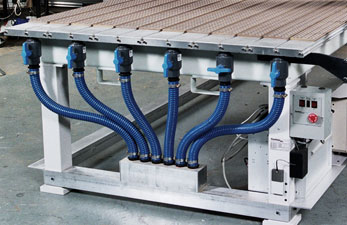In the world of precision manufacturing, CNC routers equipped with vacuum tables have revolutionized the way materials are processed. These advanced machines offer unparalleled accuracy and efficiency, making them essential tools for woodworkers, metal fabricators, and hobbyists alike. Understanding their functionality and benefits is crucial for anyone looking to enhance their production capabilities.
This guide will delve into the intricacies of CNC routers with vacuum tables, exploring their design, operation, and applications. Readers can expect to learn about the various components, setup procedures, and maintenance tips that ensure optimal performance. Additionally, we will cover best practices for material handling and troubleshooting common issues.
By the end of this guide, you will have a comprehensive understanding of how to effectively utilize a CNC router with a vacuum table. Whether you are a beginner or an experienced user, the insights provided will empower you to maximize your machine’s potential and achieve superior results in your projects.
Definitive Guide to Router Vacuum Tables and Pumps for CNC & DIY
Introduction

Vacuum Tables are often the best solution for the flat sheet work often being done on CNC Routers. You can lay an MDF spoilboard right on top of a vacuum table, and it’s porous enough to still pull a vacuum. Granted, unless you have a lot of vacuum available, you may want to seal part of the spoil board so the area receiving the vacuum is limited. Vacuum tables can be set up with zones that can be turned on and off with valves as well.
Understanding Vacuum Tables
Vacuum tables operate on the principle of creating a pressure difference between the top and bottom surfaces of the material being held. This pressure difference generates a significant holding force, making them ideal for CNC applications. The effectiveness of a vacuum table is determined by its design, the vacuum pump used, and the material being machined.
Technical Features of Vacuum Tables
| Feature | Description |
|---|---|
| Holding Force | Depends on the vacuum pressure and surface area of the material. |
| Material Compatibility | Works well with MDF, plywood, and other porous materials. |
| Zoning Capability | Allows for selective vacuum application to different areas of the table. |
| Pump Type | Can use regenerative blowers, rotary vane pumps, or liquid ring pumps. |
| Surface Area | Larger surface areas provide more holding force but require more vacuum. |
| Maintenance | Regular checks for leaks and surface flatness are essential for performance. |
Types of Vacuum Tables
| Type | Description |
|---|---|
| MDF Vacuum Tables | Use MDF as a top layer to distribute vacuum evenly across the surface. |
| Aluminum Vacuum Tables | More durable and accurate, but can be more expensive to manufacture. |
| Plenum Vacuum Tables | Feature a chamber design to enhance vacuum distribution and reduce leaks. |
| DIY Vacuum Tables | Custom-built solutions that can be tailored to specific needs and budgets. |
Advantages of Vacuum Tables
- Enhanced Precision: Vacuum tables provide a stable platform, reducing the risk of part movement during machining.
- Versatility: They can accommodate various materials and part sizes, making them suitable for different projects.
- Time Efficiency: Quick setup and removal of parts streamline the workflow, especially in production environments.
Disadvantages of Vacuum Tables
- Initial Cost: The investment in a quality vacuum pump and table can be significant.
- Maintenance: Regular maintenance is required to ensure optimal performance and prevent leaks.
- Limited to Flat Parts: Vacuum tables are best suited for flat materials and may not work well with irregular shapes.
Choosing the Right Vacuum System
When selecting a vacuum system for your CNC router, consider the following factors:
– Pump Capacity: Ensure the pump can handle the size of your table and the materials you plan to use.
– Table Size: Larger tables require more powerful pumps to maintain adequate vacuum levels.
– Material Type: Different materials may require different vacuum setups to achieve optimal hold-down force.
Popular Brands and Models
- CNC Cookbook: Offers a variety of resources and guides for building and using vacuum tables.
- IDC Woodcraft: Provides insights into vacuum clamping specifically for benchtop CNC routers.
- Laguna Tools: Known for high-quality CNC equipment, including vacuum tables.
- Grizzly: Offers a range of CNC routers with integrated vacuum systems for enhanced performance.
Conclusion
Vacuum tables are an essential tool for anyone working with CNC routers, providing a reliable method for holding materials securely during machining. Understanding the technical features, types, and advantages of vacuum tables can help you make informed decisions for your projects. Whether you choose to build your own or invest in a commercial solution, vacuum tables can significantly enhance your CNC machining capabilities.
FAQs
1. What is a vacuum table?
A vacuum table is a workholding device that uses suction to hold materials in place during CNC machining.
2. How does a vacuum table work?
It creates a pressure difference between the top and bottom surfaces of the material, generating a strong holding force.
3. Can I use a vacuum table for all materials?
While vacuum tables work well with porous materials like MDF, they may not be suitable for irregularly shaped or non-porous materials.
4. What type of vacuum pump is best for a CNC router?
The best type depends on your specific needs, but regenerative blowers and rotary vane pumps are commonly used.
5. How do I maintain my vacuum table?
Regularly check for leaks, ensure the surface is flat, and clean the table to maintain optimal performance.









